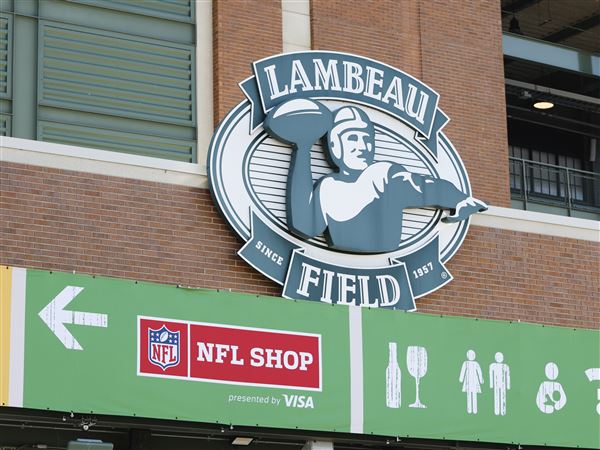This stretch of Penn Avenue in the Strip District is knife central.
You can pry into things between chefs and their knives, find a new knife for yourself, take home a second-hand chef knife as sharp as it is cheap, even lug a drawerful of dull blades to be resharpened while you wait.
For chefs, knife love is often a monogamous relationship. Forget the cooking school picture of students slung with fat quivers of knives. Most chefs light up talking about a favorite knife, maybe two. The ones they choose may surprise you.
I envy my in-laws' family knives. They are black as a crow's wing, carbon steel, light, razor sharp and a joy to use. Here is an ode to two generations of them from my sister-in-law Mary Pennell, who uses hers every day:
"I'm here to tell you, Dad instilled in us growing up in Stillwater, Minnesota, a reverence for his carbon-steel knives.
"Never, never put them in the dishwasher -- ruin for the handles as well as the blades.
"He sharpened his knife before each and every large piece of meat, at least once a week, evidenced by his knife and the sharpening stone, both now barely there. Like a worn doorstep.
"They really should be retired to a point of interest in the kitchen -- a record of the glorious hunks of meat and sandwiches we lived on. Sandwich architecture was a serious endeavor: black bread, a wheel of blue cheese, sliced cucumbers. Stainless steel knives were an embarrassment! Not present in our kitchen.
"I'm wondering if Julia Child's birthday and the jerk back to the '60s has brought on this renewed appreciation of the 'rusty knives.' Which will not rust if they are cared for properly -- just like the cast-iron skillets.
"All of my knives were purchased or gifted in the '60s. All are in good condition ... could use a sharpening. The stones are at the ready."
--Virginia Phillips
To see action step up to the counter at Penn Avenue Fish Co. Chef owner Henry Dewey and his crew of fishmongers and sushi chefs relish an audience.
"I think we've got the baddest knife guys going in this building."
The young blades at the Penn Avenue Fish wield distinctive Japanese knives.
The boss's go-to knife is a "deba," shorter than a chef's knife, with a blade about 6.5 inches long. Deba in Japanese simply means pointed carving knife. This one with its raw wooden handle, not a bit ergonomic-looking, and a well-darkened blade, is a thing of fierce beauty, its form unchanged since samurai times.
The blade is sandwich construction: the outer layers are steel but not stainless, so they acquire a dark patina. The outside layers protect an inner layer of carbon steel -- much harder than most stainless alloys, which can be easily be sharpened to a razor edge (literally, it should whisk hair off your arm), but brittle and susceptible to oxidation.
"They rust easily," Mr. Dewey says, "but clean up fast with 'carrot and Comet,' like the old Japanese guys use."
The advantage: "Carbon-steel blades keep their edge forever."
(Carbon-steel knives, beloved by Julia Child, fell out of favor when stainless appeared in the '70s but are making a comeback. See sections below.)
He flips the knife to show it is sharpened or beveled on only one side, making for a thinner, lighter blade. The unsharpened side is slightly concave. The single-bevel with hollowed reverse side is meant to ride against the fish bones, separating the filet. Which side is sharpened depends on whether the user is right- or left-handed.
The knives are versatile: "You can cut off a fish head or slice some sashimi with these. We use them for all of our kitchen prep." The fare is mostly fish-centric, suited to the knife.
For cutting through bones, Mr. Dewey would reach for a heavier knife. "Any break you can give your knife is a break for the longevity of the blade."
A musketeer set of three debas is ranged alongside the cutting table. These belong to Mr. Dewey, executive fishmonger Timmy Reynolds, 34, and fishmonger Kyle Houghtelin, 26. The knives may look identical, but Mr. Dewey says, "If I pick up Timmy's, I can definitely tell the difference."
It's Wednesday morning, and the tuna has come in. Mr. Dewey excuses himself to separate the 177-pound half fish from its bones.
Taking up the narrative is sushi chef Sopana "Pana" Sin, 33, a Cambodian immigrant who landed in Lawrenceville at age 3. Pana is subbing today for vacationing executive sushi chef Johnny Han, 32. Mr. Sin pulls out a phone to show a feat. You can watch his very long narrow sushi knife whoosh horizontally through a standing cucumber. With nary a shiver, the cuke stays vertical, top half resting on the bottom. Another member of the team is Owen Siw, 30, Chinese by birth from Malaysia, who presides over sushi at the market's Downtown restaurant.
It takes Mr. Dewey all of five or six minutes to cut the tuna: "A dull knife messes up your shoulder. A sharp one makes everything easy."
He adds, "We try to have craftsmanship here -- say, for filleting a flounder. It makes our act a little more exciting."
The crew takes pride in knife maintenance. Mr. Dewey shows the small square whetstones resting in water that Mr. Han uses to keep his 14-inch knife sharp. Water is a more delicate lubricant than more commonly used oil. After use, the sushi knives are wiped, hand-dried and stored in their skinny boxes.
An old Eye-Hook belt grinder in the basement re-edges the store's utility knives, such as the plastic handled Dexters and fish-skinners.
Mr. Dewey skipped chef school, honing his fish skills in Key West and Manhattan. He first cut fish with Japanese chefs at Manhattan's Duane Park Cafe in Tribeca in the early '90s.
"I was a white boy from New Jersey. When you work with Japanese you learn to respect the product. They taught me to filet a trout -- open it like a book, take out every bone and pin bone. And that meant I could cut salmon: trout and salmon have identical skeletons."
He's cut and cooked at a furious pace since, at Big Burrito Group's Casbah and as Soba's first executive chef; then at the Steelhead Grill, putting in an extra shift at the now-shuttered Benkovitz, to do what he loves best, cut fish. He learned something else at Benkovitz: "I found that giving simple recipes was priceless. People were scared by expensive fish." He's famous for those high-power cooking haikus. Just ask.
The fish market's sushi chef Johnny Han is two doors away having cocktails at Bar Marco. The wine bar/restaurant, just a year old, housed in an 1860s former firehouse, serves small plates, entrees and weekend brunch. In its first months the restaurant had no real chef but was cranking out well received daily menus with four intelligent amateurs in their 20s sharing kitchen duties.
Mr. Han sitting, sipping, takes it all in.
"Oh, you gotta sharpen knife," he observes, and proceeds to teach Michael Kreha, Justin Steel, Bobby Fry and Kevin Cox basic cutlery care.
Now Bar Marco has a chef, John "Juan" Heidelmeier, 24, who arrived this summer by way of Soba, Legume and Root 174. He was christened Juan when there were two Johns in the kitchen.
If the grinning Henry Dewey is urban energy, buzz cut, ear studs, never without his carved Maori bone fishhook worn round his neck -- "for luck in water endeavors" (he is a man with a boat who fishes every chance he gets, likely to show you a phone portrait of a longnose gar, a prehistoric brute that gave him a 15-minute fight on the upper Allegheny near the Highland Park Bridge), then Chef "Juan" Heidelmeier, next door, offers a contrast.
The blond 24-year-old, restrained in manner, is land-based. On his laptop see photos of him doe hunting from a tree, plus shots of chanterelles he found in the woods. You may spot him on his cargo bike, commuting to work from his Lawrenceville home.
The Pittsburgh Culinary Institute grad is a DIY guy with Texas roots. Born in Austin, he learned to hunt with his dad, who calls his son an "outdoorsman with a capital O."
A tattoo outline of a chef knife on one arm and a carpenter's saw on other hint that the chef is knife-minded -- to the point of making them from scratch.
Mr. Heidelmeier didn't make the one he's using most in the kitchen: a thin-bladed $5 Chinese veggie cleaver his dad got him in Texas.
"You can use it for so many things -- chop, slice, pick up and transfer things you've chopped, scrape dough, move something on the grill." Moving fast in tight quarters? "Cleavers have no points to stick yourself -- or someone -- on.
"If I can make a vegetable cleaver, I'll be satisfied," he says.
For colleague Justin Lewis at Bar Marco, though, Mr. Heidelmeier is repairing a vintage treasure. He is giving a new rosewood handle to Mr. Lewis' 60-year old carbon-steel meat cleaver, its edge worn into a crescent shape by decades of sharpening.
Cleavers have been having a moment in home kitchens as well, particularly the smaller Asian-style veggie knives, cited by the New York Times' Florence Fabricant writing on knife trends, popularized by Rachel Ray, and compared in a Cooks Illustrated test. People like them, as does Mr. Heidelmeier, as multi-purpose tools.
Any trend here among young chefs using cleavers for general prep instead of a chef's knife? "Yes! It's [B.S]," shouts Bill Fuller, Big Burrito executive chef, flourishing a 12-inch chef's knife at a recent Farmers@Firehouse demo. "Cleavers -- they're like tattoos; it'll be over in a year."
Legume owner Chef Trevett Hooper says he'll stick with his chef's knife, except for butchering.
Cleavers or no, chefs and foodies like hand-made knives. The Bar Marco basement is a man-cave of machines for transforming sheet metal and salvaged logs into sleek tools with silken handles. Chef Heidelmeier plans to operate a knife shop here. You can see a blade shape -- destined to be a chef knife for Bar Marco's Justin Steel. It was cut from sheet stainless by a metal saw called an angle grinder. The sheet comes from a Texas knife-making supplier (plenty of Texas people, including the Heidelmeiers, make Bowie knives for hunting). The blade will be ground, then tempered by "heating with a blow torch and quenching in old motor oil."
Mr. Heidelmeier will use a belt sander and planer to shape cherry and maple logs, scavenged locally, now aging in the Bar Marco basement. "A piece of wood is dry enough when you can hit it with an ax" -- in the restaurant parking lot -- "and it splits. I love selecting the grain," he says.
The workshop is fragrant with mounds of maple sawdust. "My dad, Joe, has two barbecue pits in his backyard, one monogrammed. I learned from him about smoking meat over wood -- mesquite, maple, hickory, cherry." Mr. Heidelmeier will translate this for stovetop and Weber grill smoking, so watch for smoked pork and brisket on the Bar Marco menu.
And you also may place your order for a custom blade.
In the Kitchen
1725 Penn Ave., 15222
412-261-5513
To outfit yourself with new cutlery, consult third-generation specialist Mitchell Holt, 27, whose knife-sharpening great-grandfather plied the streets of the North Side in a horse and buggy. Mr. Holt holds court at the "wall of knives" at In The Kitchen on Penn Avenue.
Catering to cooks of all skill levels, the display runs the gamut from plastic-handled "Dexters" -- Dexter-Russells, the budget mainstay in restaurant kitchens -- to specialty knives costing several hundred dollars each. The store sharpens knives too, for $3 each. You may need to leave them for a few days.
Mr. Holt says knife "sets" are on the wane. Here are the knives you need:
• 8- to 10-inch chef knife, with good rocking motion
• 3- to 4-inch blade paring knife, for coring tomatoes, separating silverskin from a roast
• serrated blade, for slicing bread.
An optional fourth would be a thin, curved boning knife. "An inexpensive plastic-handled Dexter is good." Fifth would be a flexible fileting knife, "the very best for fish."
An option not mentioned: Even though we slice hulking fowl, hams and roasts a few celebratory times a year, a long, 10- to 12-inch carving knive, very narrow and very thin, is a joy to have. If only we had a sushi knife, it would be perfect. In lieu of that consider a high-performing -- and wonderfully inexpensive -- second-hand carbon steel roast-slicer at Maturi Brothers below.
Knife quality: Forged vs. stamped. Dexters are a good example of inexpensive "stamp" knives. "The process is simple: blades are stamped from sheet metal, ground and trimmed. They resharpen well. Forged knives are made with a higher grade of steel, rolled a few times and the edge pounded. They have a much longer life span. Stainless ones from the early '70s still sharpen well."
How to use a honing rod or steel? It's all in the angle. Mr. Mitchell will give you a lesson. "Steels do not sharpen," only straighten invisible deformations on a blade's edge, extending sharpness for a while.
Those grantons? The dimples that recently began appearing on blades. "They probably do allow air into a cut, so the knife moves better when slicing vegetables and meat. Now they are putting them on everything."
Maturi Brothers, Inc.
412-682-5828
3908 Penn Ave., 15224
What about those stainless steel knives from the '90s -- thousands of them, lying in kitchen drawers across America, dull as butter-spreaders? If you own these or any dull knife except ceramic, Maturi Brothers has a deal for you.
The company's primary purpose is to sharpen knives for the professional food community -- some 1,000 local businesses, including restaurants, Panera and the Giant Eagle stores. Maturi essentially rents cutlery, dropping sharp knives and collecting dull ones, over several counties on a two-week rotation.
"We're not unique," says Rick Secola, who owns the business with a cousin. "All cities have services like ours."
The century-old business was founded by an Italian immigrant named Maturi, who organized a group of mostly Italian knife sharpeners squabbling over territories. Rick Secola's father ended up buying it. It's been on Penn Avenue for 50 years.
What may be unusual is that anybody can bring knives to the shop, 7 a.m. to 3 p.m., to be sharpened while they wait. Maturi is a spacious place of many specialized, water-cooled grinders. The cost for most knives is $2.
They also sharpen meat grinder plates, slicers, scissors, lawn tools, saws, even kitchen knives with serrated blades. These you may need to leave for a few days.
Here's the fun: You can sort through bins of countless used plastic and wood-handled knives -- all priced at two bucks.
If you hanker for a carbon-steel knife, Mr. Secola can find a used one for a modest price. I took my Mom's 1950s sewing scissors and a very old paring knife with a missing tip as a test and got them back good as new.
A hint: Don't take your knives right before Thanksgiving or Easter when half of Pittsburgh wants a sharp knife for the holiday roast.
Julia Child would have no others. Carbon-steel blades take an edge better and hold it longer than stainless steel, although they darken with time and need careful drying to avoid rust.
They fell from favor in the '70s with the appearance of stainless steel, but they're being rediscovered. Artisan knife makers are forging them. Japanese cutlery makers never stopped making them. The French have always championed them. Major European makers are capitalizing on the comeback.
Sur La Table offers a signature carbon-steel line created by Zwilling J.A. Henckels to specifications by the cult knife-maker Bob Kramer of Olympia, Wash. The 10-inch chef's knife is $350. In The Kitchen's Mitchell Holt says Wusthof is planning an anniversary carbon-steel collectors knife, which if popular, will go mainstream.
You can find them used -- a local source is Maturi Brothers (see that section).
From Rick Secola at Maturi Brothers and Mitchell Holt at In the Kitchen:
Keep all knives out of the dishwasher. The temperature changes loosen the handle; detergents dull the blade.
Use only wood or plastic cutting boards; it is the cutting surface, not the food you cut, that flattens the edge.
Your knives should have a good resharpening once or twice a year, depending on how heavily you use them.
First Published: November 29, 2012, 10:00 a.m.
















